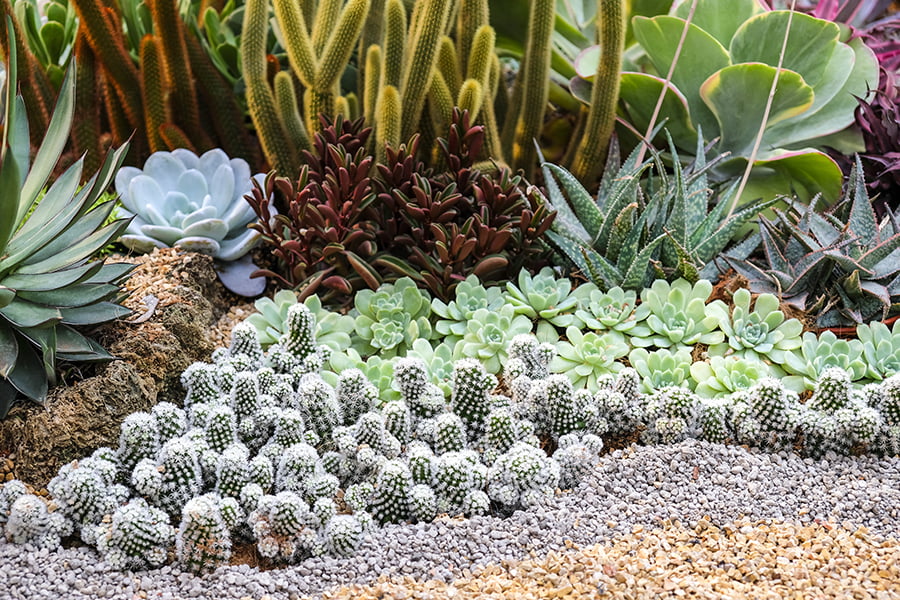Xeriscaping is a great way to create a low-water lawn. It involves using drought-tolerant plants, mulch, and other water-saving techniques such as grouping plants with similar water needs together, using efficient irrigation systems, and maintaining healthy soil.
Xeriscaping is a great way to create a beautiful, low-water lawn without sacrificing aesthetics. It uses native plants and landscaping techniques to reduce water usage and still maintain an attractive outdoor space.
In this blog post, we’ll discuss what xeriscaping is, how it works, and provide tips for creating your own low-water lawn using xeriscaping principles.
Look Inside:
Choose Drought-tolerant Grasses

Choosing the right type of grass for your xeriscape is essential in order to achieve a beautiful, low-maintenance lawn. Drought-tolerant grasses are able to survive with minimal water and can thrive in hot climates.
These types of grasses include Bermuda, Zoysia, Buffalo, Fescue, and St. Augustine varieties.
Each type has its own unique characteristics such as color, texture, growth rate and drought tolerance level so it’s important to research which one will work best for your specific climate and needs. These types of grasses require less mowing than traditional turfgrass varieties so they are also great for those who want an easy maintenance lawn without sacrificing aesthetics or quality.
Select Native Plants

Native plants are those that naturally occur in the local environment and have adapted to the climate and soil conditions of the area. By selecting native plants for your xeriscape, you can ensure that they will require minimal water and maintenance while still providing an attractive landscape.
Native plants also provide food and shelter for wildlife, making them an important part of any sustainable garden. When selecting native plants for your xeriscape, consider their size, shape, color, texture, bloom time and drought tolerance.
Research which species are best suited to your particular region so you can choose ones that will thrive in your climate without needing extra water or care.
Group Plants With Similar Water Needs Together

This means that when creating a low-water lawn, you should group plants that require the same amount of water in one area. For example, if you have some plants that need more water than others, they should be placed together so they can share the same irrigation system or watering schedule.
By grouping plants with similar water needs together, you can ensure that each plant gets the right amount of moisture without wasting any extra resources. This will help to create a more aesthetically pleasing landscape as all your plants will look uniform and well-maintained.
Use Mulch to Retain Moisture in the Soil

Mulch acts like a blanket for the soil, helping to keep water from evaporating and allowing it to be absorbed by plants. It also helps prevent weeds from growing and competing with your lawn for water.
When using mulch in a xeriscaped lawn, it is important to use organic materials such as wood chips or shredded bark that will break down over time and add nutrients back into the soil. Spread the mulch around your plants at least two inches thick, making sure not to cover any stems or leaves.
This will help keep moisture in the ground while still allowing air circulation so that roots can breathe.
Install a Drip Irrigation System

A drip irrigation system works by slowly releasing water directly onto the soil and plants, allowing for more efficient water usage. This type of system can be installed in various ways, such as using soaker hoses or individual emitters that are connected to a main line.
The emitters can be adjusted to release different amounts of water depending on the needs of the plants and soil. Drip irrigation systems also help reduce evaporation and runoff, making them an ideal choice for xeriscaping projects.
Create Berms and Swales to Direct Water Flow Away From the Lawn Area

One of the most effective techniques for xeriscaping is creating berms and swales. Berms are mounds of soil that are built up around the perimeter of the lawn area, while swales are shallow trenches that run along the edge of the lawn.
These features help to direct water away from the lawn area, reducing water usage and helping to keep your grass healthy and green. By using berms and swales in combination with other xeriscaping techniques such as mulching, you can create an attractive low-water lawn that will save you money on your water bill.
